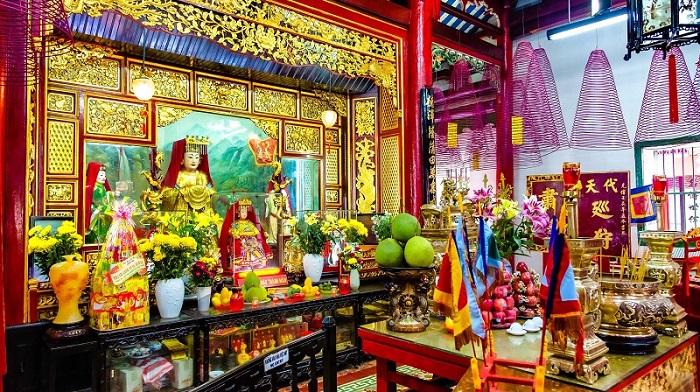Comprehensive Guide to Exploring Phuc Kien Assembly Hall in Hoi An from A to Z: Don’t Miss It!
Located at 46 Tran Phu Street, Phuc Kien Hall is a historical and spiritual destination in Hoi An’s ancient town. Visitors are drawn to this place for its rich historical, cultural, and artistic values.
1. Where is Phuc Kien Assembly Hall?
Phuc Kien Hall is one of the most famous tourist attractions in Hoi An. It was built by the Phuc Kien people who settled in Hoi An for generations. Its central location in the ancient town makes it convenient for tourists to visit the Assembly Hall and nearby attractions.
- Address: 46 Tran Phu Street, Hoi An City, Quang Nam
- Opening hours: 7:00 AM to 5:00 PM daily
- Admission fee: As it is one of the paid attractions in Hoi An, visitors should be prepared to pay an entrance fee of 80,000 VND per Vietnamese visitor and 150,000 VND per foreign visitor.

2. Exploring the History of Phuc Kien Assembly Hall
2.1. What is Phuc Kien Assembly Hall in English?
Phuc Kien Assembly Hall, dates back to the 16th century. It not only carries a long history but is also an outstanding example of cultural architecture in Hoi An. Its magnificent architecture, adorned with eye-catching red colors and exquisite decorations, adds to the charm of Hoi An’s ancient streets.
2.2. Who is Worshipped at Phuc Kien Assembly Hall?
Legend has it that the predecessor of Assembly Hall was a small shrine dedicated to Thien Hau Thanh Mau (the Goddess of the Sea who protects merchants at sea). This shrine was salvaged from Hoi An’s seashore in 1697. Over time, the Assembly Hall became a gathering place for the Phuc Kien people, who were among the earliest settlers in Hoi An.
Through several renovations and with contributions from the overseas Chinese community, Phuc Kien Assembly Hall has become more splendid, enriching the architectural heritage of Hoi An. Visitors can admire the skilled craftsmanship and aesthetic sensibility of the past.
3. Travel Tips for Visiting Phuc Kien Assembly Hall
3.1. Precautions Before Entering Phuc Kien Assembly Hall, also known as Phuc Kien Pagoda, is a place of spiritual significance with solemn rituals. Therefore, visitors are advised to dress modestly and conduct themselves respectfully to maintain the sacred atmosphere inside the pagoda. Inside the pagoda, there is an area where incense and ceremonial items are sold for visitors to make offerings, so there’s no need to bring these items from outside.
Additionally, on festival days or full moon days, the place tends to be crowded. Visitors should be cautious and mindful of their belongings to avoid any pickpocketing incidents. If you prefer not to walk too much, you can rent a bicycle or a cyclo to reach the Tam Quan gate and then proceed on foot to the pagoda.
3.2. Activities to Explore at Phuc Kien Assembly Hall
Among the Assembly Halls in Hoi An, Hall boasts the most spacious and beautiful architecture. Originally built from wood, it was later restored with brick and tiled roofs. Visitors come to admire the intricate and skillful architectural details.
- Explore the Tam Quan Gate: The Tam Quan Gate is entirely decorated with ceramics, featuring curved yin and yang tiled roofs. The gate has three entrances, symbolizing “Heaven, Earth, and Humanity.” According to ancient beliefs, the middle gate is rarely opened, except on special occasions like major festivals, funerals, or weddings.
- Garden and Main Courtyard: As you step through the Tam Quan Gate, you’ll find yourself in a spacious garden with a beautifully crafted fountain featuring intricate dragon motifs, surrounded by lush greenery. To fully appreciate the scenery, take your time walking through the gate, garden, pond, decorative trees, the two rows of east and west houses, the main hall, the back courtyard, and the rear hall.
- Main Hall (Dien): Inside the main hall, you can find altars dedicated to Thien Hau Thanh Mau, Quan The Am Bodhisattva, Thanh Tai (the God of Wealth), 12 female deities, and 3 Fertility Goddesses. All of these are displayed with great reverence alongside valuable relics.
- Rear Hall (Hau Dien): The rear hall is where local residents and visitors light large incense coils to pray for health and prosperity for their families and loved ones. Notably, these incense coils can burn for over 30 days, and if they are extinguished, the Assembly Hall’s organizers will rekindle them.
In addition to these attractions, Assembly Hall also houses various statues, bronze bells, bronze drums, and precious ornamental screens.

3.3. Religious Activities at the Pagoda
Many people believe that Assembly Hall is a sacred place where wishes can be granted. Therefore, both local residents and international visitors come here to seek blessings. The pagoda is most crowded on full moon days, traditional Tet holidays, such as the Lantern Festival (15th day of the first lunar month), the Sixteenth of February Festival (16th day of the second lunar month), and the Birthday of the Goddess Thien Hau (23rd day of the third lunar month). During these times, various fascinating festivals and activities are organized to attract tourists from both within and outside the country.
Particularly, on the second day of the second lunar month, the local Chinese community in Hoi An holds a ceremony to worship the God of Wealth, offering items like paper money, gold and silver, wine, and a special dish called “tam sen” (boiled eggs, crabs, and pork).
4. Nearby Tourist Attractions
After visiting Phuc Kien Assembly Hall, tourists can explore several nearby attractions, including Hoi An’s night market, the Japanese Covered Bridge (Chua Cau), Trieu Chau Assembly Hall, Phung Hung Ancient House, Hoi An Museum of History and Culture, Hoi An Museum of Folk Culture, and more. These places are within a 10 to 20-minute walk from Phuc Kien Assembly Hall.
Enjoy your visit to Hoi An and the cultural richness of Phuc Kien Assembly Hall!

